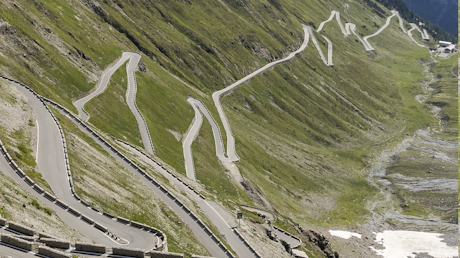Driving to Italy from the UK: top tips
August 23, 2022 by carwow staff

Longing for a lengthy road trip to Italy? Our guide has all the information you need in advance
One of the greatest things the motor car offers is the promise of freedom – the ability to drive where you want, when you want.
And once you’ve crossed over the Channel and have entered mainland Europe, a huge proportion of the world is your oyster, with Italy being one of the countries you might consider driving to – not least if you want to avoid the usual stresses and uncertainties inherent in air travel.
There are a few key things to know before you hit the road, though, and this guide will walk you through them.
What do I need before driving from the UK to Italy?
You will clearly need a full UK driving licence, and you must also be over 18 years of age to drive in Italy.
Although you may not be asked for them at any point, it’s a good idea to take your insurance certificate, plus a copy of your car’s V5C logbook.
Be sure to pack high-visibility vests, too, as while it is not mandatory to carry these in Italy, you could be fined if you break down and do not wear one on a hard shoulder.

You’ll want European breakdown cover, too, so check with your provider if this comes automatically with any policy you may have.
Oh, and don’t forget a country of origin sticker for your car: this is now a ‘UK’ badge rather than a ‘GB’ one.
What does my car need before driving from the UK to Italy?
It’s a good idea to give your car a thorough checkover before any long journey, ensuring all its fluids are at the right level, checking all your lights are working properly, and making sure the tyres are in decent condition and at the correct pressure.
Italy drives on the right, so work out if you need stick-on headlight converters to stop your car from dazzling other drivers at night, or if your car has a mode that changes the angle of the headlight beam.
Some modern cars will use GPS technology to automatically detect what country you’re in and adjust the headlights accordingly, while other vehicles may need to be told to switch their lights to left-hand-drive mode. Consult your vehicle handbook for more information.

You will also need to ensure your car has a hazard-warning triangle, and it is recommended to have a spare set of bulbs for your car as well.
I’ll be driving through France – what else do I need?
You’ll need the reflective vests mentioned above, but you will need one for each vehicle occupant. Also pack a disposable alcohol breathalyser.
If you’re driving through Paris, you’ll need to pay for a Crit’Air (short for Certificat qualité de l’air) sticker. This displays your car’s emission class, with cars that do not meet Euro 4 emission criteria being banned from entering the area inside Périphérique ring road between 8am and 8pm, Monday to Friday.
Do I need the same if I’m going through Belgium and Germany?
Regulations in Germany and Belgium are broadly similar to those in other EU countries (drive on the right, warning triangles are mandatory, adjust your headlights), but if you’re taking in Germany, you may be tempted to stretch your car’s legs on the autobahn.
Do note not all sections of the German motorway network are unrestricted, and you should be confident in both your car’s mechanical condition and your own abilities as a driver before making any kind of speed run.
How much will it cost to drive from the UK to Italy?
This depends on where in Italy you are going to, how efficient your car is, and where you will be stopping overnight – the journey to Italy is too long to responsibly cover in one day.
Let’s say you’re heading from London to Milan via France, a distance of roughly 800 miles. If your car manages a consistent 35mpg in the real world and runs on petrol, that’s 23 gallons (105 litres) of fuel, with French and Italian prices being roughly €1.80 for a litre of unleaded, so in petrol alone you’ll be spending roughly €189, or roughly £160.
If you’re driving to Bari on the south-east coast of Italy, that’s more like 1,330 miles, which would bring your fuel costs to something in the order of £262 at 35mpg.
Let’s add in another £300 for accommodation and food (this will vary enormously depending on your taste in food and hotel, and how many people are in your party), and you’re looking at somewhere around £500-£600 for your journey – though these are very rough estimates.
You will also need to factor in the cost of Autoroute tolls in France, and Autostrade tolls in Italy.
Where should I stop on the way if I’m driving from the UK to Italy?
Again, this depends on where you are travelling to in Italy, and what route you are taking on your way there. Lyon, Cologne, Dijon, Strasbourg and Reims in France could all work for an overnight stop, or you might want to make a detour to the Nürburgring in Germany, or check out Geneva in Switzerland.
If you’re heading further into Italy than Milan, you may want to pay Bologna or San Marino a visit, while those after scenic routes could consider taking in the coast from Monaco and Nice into Genoa, or checking out the Alpine passes from Germany and Austria, or heading through the Mt Blanc tunnel in Switzerland. It’s a long trip, with multiple route and stop-off options, and you will be best-placed to decide where you would like to see on the way.
How long will it take me to drive from the UK to Italy?
As mentioned above, Italy is a big place, and it depends where you are going – but allow anything from 13 to 30 hours, not including rest and overnight stops.
What’s it like, driving in Italy itself?
It’s reasonable to expect a country that is home to the car makers Maserati, Lancia, Alfa Romeo, Ferrari, Lanborghini and Pagani will have enthusiastic drivers, and that’s very much the case with Italy.
Some might find the prospect of driving in Italy intimidating, but many people return from an Italian road trip with positive memories of the driving.

A few Italy-specific rules to bear in mind:
- On narrow mountain roads with room for only one vehicle, the vehicle that is descending must reverse to a passing place.
- It is technically not allowed to sound your horn in urban areas. Judge for yourself how well this rule is adhered to.
- Urban speed limits are 50-70km/h (31-44mph)
- Outside town the limit is 90-110km/h (56-68mph)
- Autostrade (motorways) have a 130km/h limit (81mph), reduced to 110km/h in rain or snow.
- Radar speed detectors are illegal
- Speeding fines can range from €40 to €4,400 (the latter being for the most serious offences), with police able to request on-the-spot payments of 25% of the fine.
- The drink-drive limit in Italy is 0.5mg of blood alcohol, less than the 0.8 allowed in the UK
Where should I go when I get to Italy?
With a history dating back to before the time of Christ and covering 116,310 square miles, there’s a reason lengthy, comprehensive guide books exist for Italy (and other countries, of course).

We’ll stick with what we know, though, and recommend visiting the Museo Casa Enzo Ferrari in Maranello, the Museo Automobili Lamborghini near Bologna, the Maserati factory tour in Modena, the Pagani factory tour in San Cesario sul Panaro, the Museo Storico Alfa Romeo just north of Milan…you get the idea.
Change cars with carwow
Looking for an easy way to change your car? Then carwow is the place to go. You can sell your car online for a great price, and get the best deals on a new one. All through our network of trusted dealers and all from the comfort of your home. Tap the button below to get started today.















